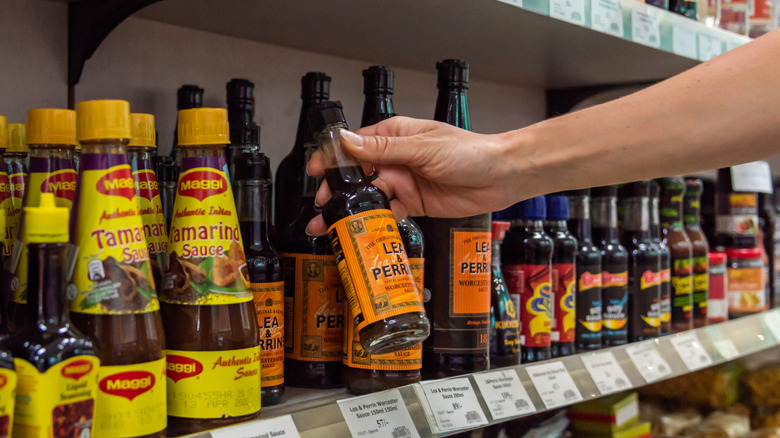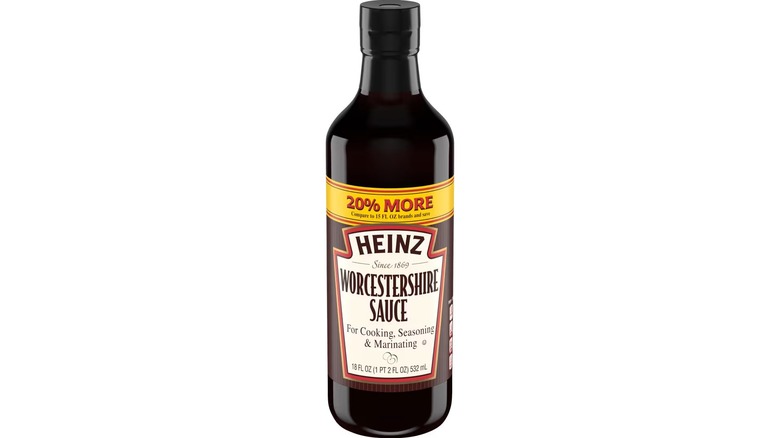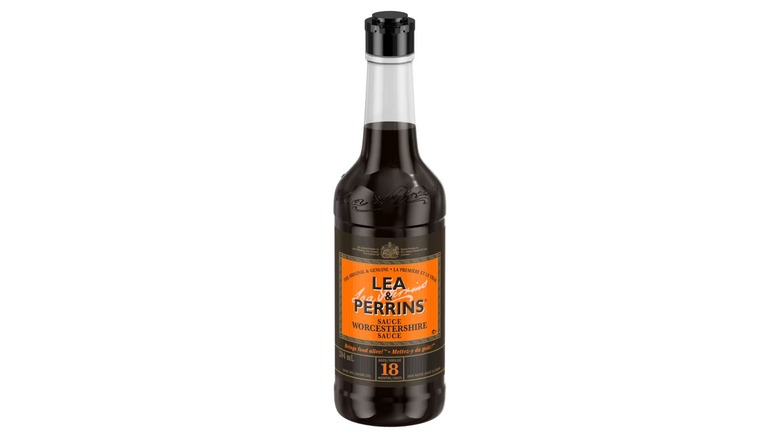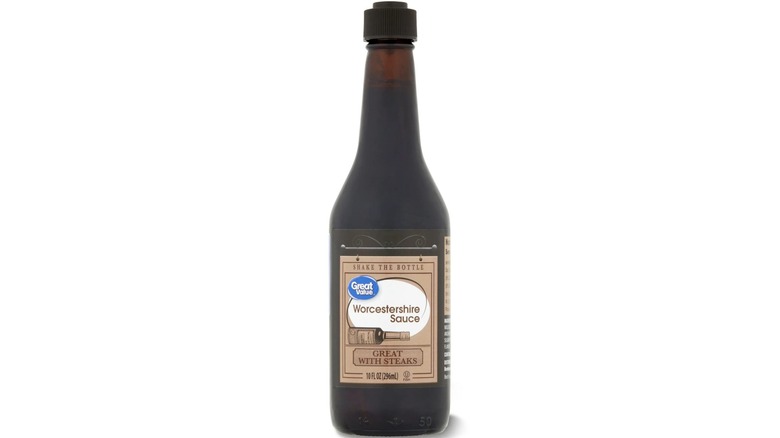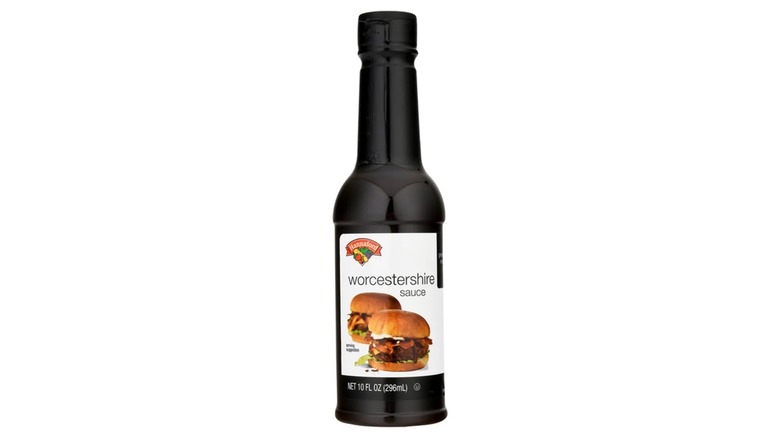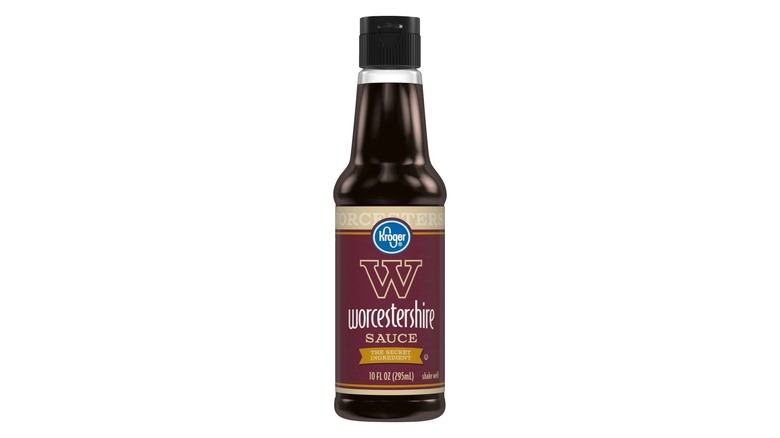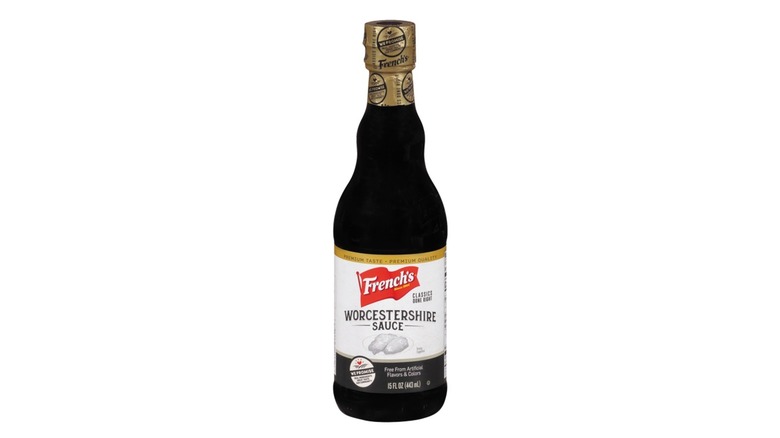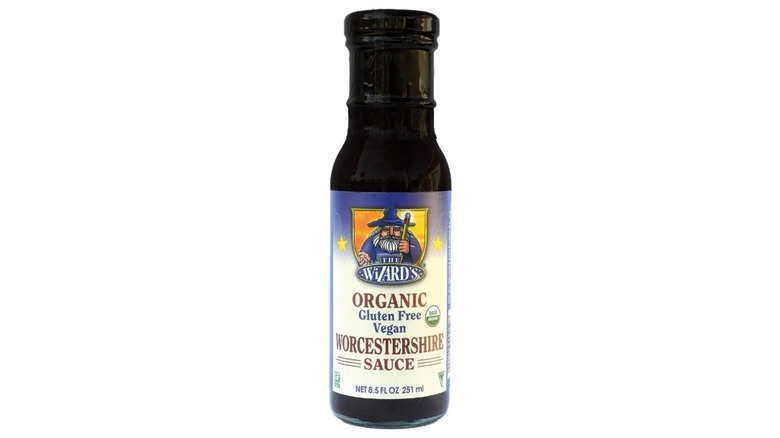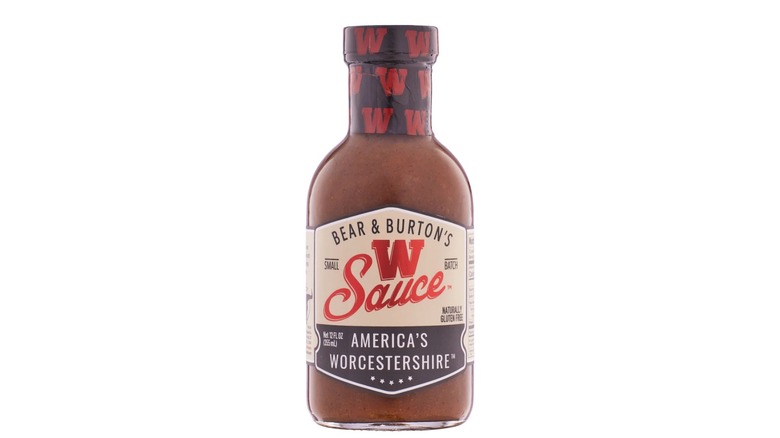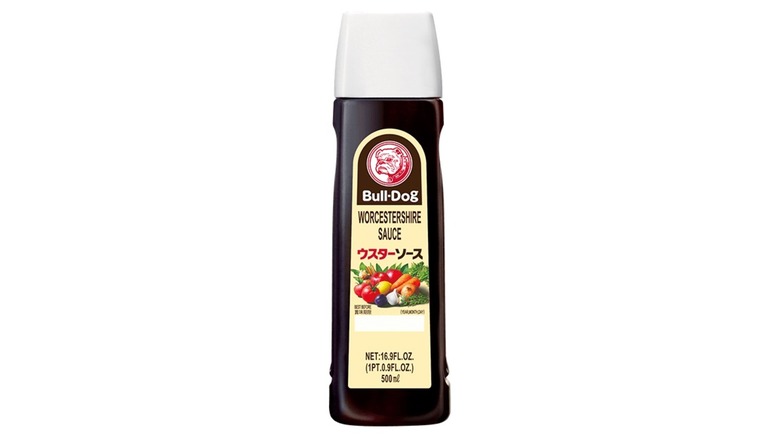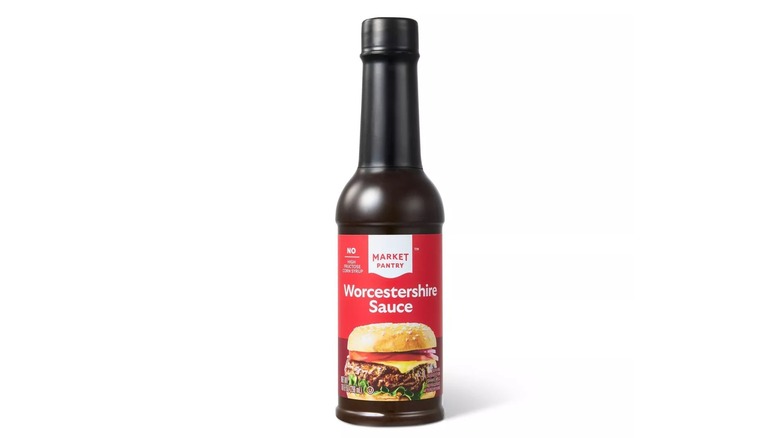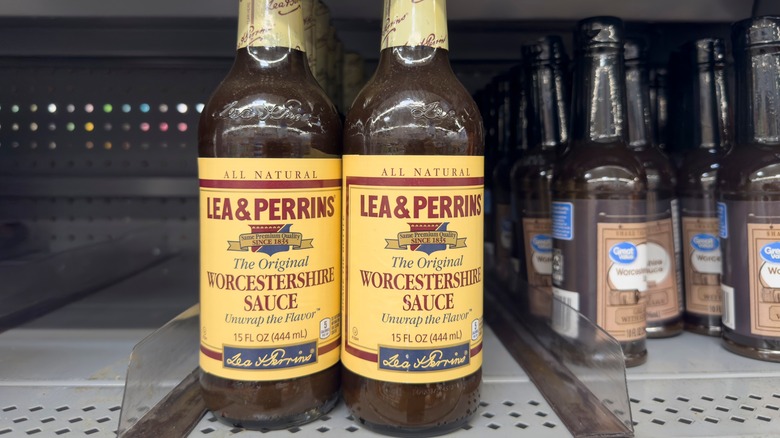5 Worcestershire Sauce Brands To Buy And 7 To Avoid
We may receive a commission on purchases made from links.
Worcestershire sauce is difficult to place in any specific condiment category. We use it liberally as an all-purpose flavor enhancer, dousing it on our meatloaf and steaks or in marinades and cocktails. It's salty, umami-driven, and sweet, and its closest relatives are maybe fermented fish sauces used in Asian cuisines. And all jokes aside, you'll have to learn how to pronounce Worcestershire before we go on.
The first — and favored — Worcestershire sauce was discovered around 1837 by British pharmacists John Wheeley Lea and William Henry Perrins. The duo had actually whipped up the concoction in 1835, but initially found it completely unappetizing. After storing it away in barrels for 18 months — and a happy accident — they discovered it had matured into the savory sauce that would go viral. For decades, Lea & Perrins kept the first batch's ingredients under lock and key, and it wasn't until the early 2000s that we got a peek at this original recipe. While the specifics have been tweaked throughout the centuries, the base ingredients have stayed the same, including vinegar, molasses, fermented anchovies, and tamarind.
Plenty of other brands have popped up on grocery store shelves besides Lea & Perrins, but many of them aren't even worth your time. To help you avoid any buyer's remorse, we've compared several different varieties, looking out for unwanted additives, exorbitant sodium levels, or flavors that just don't work. Find out which Worcestershire sauce to trust — and which to avoid — below.
Avoid: Heinz Worcestershire Sauce
Who said the makers of one of our favorite vinegar-based condiments couldn't take a stab at recreating Worcestershire sauce? In fact, after buying up the brand in 2005, Heinz is currently the parent company of Lea & Perrins. In all fairness, it delivers an acceptable range of sodium and added sugars, and its product description informs us that it's simply "developed from an old English recipe." The phrasing does a lot of heavy lifting, though, as the sauce's ingredients deviate dramatically from tradition. When one Redditor asked how close Heinz's sauce was to the original, the first reply declared: "3,207 miles from Worcestershire, U.K. to Worcester, Massachusetts."
Firstly, the condiment lacks several canon ingredients like onion, garlic, or tamarind. It also has additives like high-fructose corn syrup and caramel coloring. This latter additive is used to give sodas, pastries, and sauces a darker, more aesthetic appearance. We're probably never consuming enough to cause concern, but you're better off avoiding this ingredient, especially in combination with other preservatives. For $2.77 per 18-ounce bottle at Walmart, Heinz's Worcestershire may be cheaper, but it shows in its manufactured quality.
Buy: Lea & Perrins The Original Worcestershire Sauce
Unlike other condiments with murkier origin stories, Lea & Perrins is the definitive Worcestershire sauce. Some enthusiasts, like this Redditor, even take it to the next level: "There is exactly 1. And only 1 Worcestershire sauce."
The tangy, sweet, and savory condiment boosts the flavor of just about anything, and is naturally low in added sugars and calories. It's true the sauce delivers a whopping 65 milligrams of sodium per teaspoon, but as long as you use it as an enhancer, it shouldn't overpower the dish or your cardiovascular system.
What really makes the sauce unbeatable, though, is Lea & Perrins' commitment to the straightforward ingredients of the centuries-old recipe. Take a look at the bottle and you'll find the same proverbial components, including malt vinegar, molasses, onion, garlic, anchovies, and tamarind. No wild additives, and the brand still matures these wholesome ingredients for months to amplify the flavor. Replicating it is nearly impossible since certain spices and exact measurements are still unknown.
"L&P is definitely more tart than many others, but also has a great depth of flavor," explained one Redditor on another thread. "It is meant to be a tart sauce since malt vinegar is the base." Most American brands, (and even the Lea & Perrins in the U.S.) swap out malt vinegar for the cheaper distilled white substitute. You can still purchase the traditional Lea & Perrins on Amazon, although it does come at a steeper cost.
Avoid: Great Value Worcestershire Sauce
To give credit where credit is due, there are probably much worse Worcestershire varieties at Walmart (say that three times fast). We may have an inherent distrust of big-name store brands, but the ingredients in Great Value's bottle ring faithfully true to the traditional recipe, including distilled white vinegar, molasses, tamarind, and the all-important anchovies. The nutrition facts fall into appropriate amounts for a Worcestershire sauce, with no calories, hardly any added sugars, and 55 milligrams of sodium per teaspoon. At $1.23 per 10-ounce bottle on Walmart's website, the sauce looks like a no-brainer when you're on a budget and need something to give your soup an umami boost.
Nevertheless, Walmart pumps this sauce with some problematic additives that ultimately make it less than "great value." The condiment lists the ever-ambiguous "natural flavors," and instead of sugar, it contains caramelized sugar syrup and high-fructose corn syrup. Avoiding these cheaper – and arguably unhealthier – sugar substitutes is as easy as setting the product back on the shelf.
Regarding taste, several customers on the brand's product page complained that the sauce was too thin, the flavor too weak, and of a disproportionate amount of clove. More concerning, though, are recent reviews alleging that Great Value has switched up the ingredients. One review claims that the new bottles list "contains bioengineered food product," and have completely removed anchovies, relegating them to an afterthought in the "may contain/allergy warning" section.
Buy: Hannaford Worcestershire Sauce
Although you might get some shade if the purists find out, there are plenty of reasons to buy a more affordable bottle than Lea & Perrins. Maybe you don't feel like shelling out the big bucks on a sauce that's for your experimental Worcestershire-slathered grilled cheese, and that's okay. If you live in New England and have a Hannaford supermarket around, the store brand Worcestershire sauce is a good bet for quality and price.
The bottle's label is the definition of unassuming (they didn't even bother to capitalize), with a serving suggestion of two burgers on a white background. Its ingredients follow in a similar no-frills vein, delivering a short list of vinegar, sugar, molasses, garlic powder, anchovies, and tamarind. Each teaspoon contains 5 calories and 55 milligrams of sodium, aligning closely to Lea & Perrins' nutrition facts. Caramel coloring and some undisclosed "natural flavors" are this condiment's only drawback, but for just $1.49 per 10-ounce bottle, maybe you can look the other way.
Avoid: Kroger Worcestershire Sauce
One glance at the back of certain bottles and you'll know they're an immediate skip. Kroger's proprietary condiment unfortunately falls into this category, with an ingredients lineup that would have both Lea and Perrins rolling in their graves. For starters, it completely omits anchovies. This could be appealing for vegans or vegetarians, but it contains way too many additives to be a reasonable choice. From citric and malic acid to hydrolyzed soy and corn protein, this sauce overlooks genuine flavor and just tries to mimic it.
It also has dextrose, an artificial sweetener derived from corn. We'd like to ask what happened to just letting natural ingredients speak for themselves? Even the garlic and onion are dehydrated in this Worcestershire sauce, diminishing its depth of flavor.
Nutritionally, Kroger's take on the classic is similar to most, and it's definitely on the cheaper end of the spectrum. Even so, while the label claims that this condiment is the "secret ingredient" your meals are missing, we think your meals deserve so much better. Although the sauce has only six reviews on Kroger's website, almost all of them are disappointed. "Does not taste like the real deal at all," laments one customer.
Buy: 365 Whole Foods Organic Worcestershire Sauce
If you're on a quest to find a quality condiment without any animal products (because vegetarians deserve a splash of Worcestershire sauce in their bloody Marys, too), Whole Foods' organic rendition is one of your best bets. Shopping at this grocery chain can sometimes feel a bit pretentious, but this Worcestershire sauce's price point and wholesome list of ingredients make up for any judgement.
The store-brand condiment starts off with a base of organic white vinegar, cane sugar, and molasses, then swaps out the anchovies for a fistful of accompanying spices. These range from black pepper, garlic, and cayenne to allspice, nutmeg, ginger, and cloves, giving the sauce a rich and cozy depth of flavor. To boot, all of these spices are listed as organic. One disadvantage is that the condiment includes caramel coloring and xanthan gum, but hey, at least the latter is organic.
The nutritional profile is almost identical to Lea & Perrins, and while there's often an upcharge on vegan products, this sauce rings up for the fair price of $2.29 per 5-ounce bottle at Whole Foods. As for its flavor, the Worcestershire sauce boasts a 4.7-star rating on Amazon, out of nearly 4,000 reviews. Although the condiment takes its fair share of liberties with the ingredients, customers seem pleasantly surprised by the similarity in flavor and thickness to Lea & Perrins.
Avoid: Robbie's All Natural and Guilt Free Worcestershire
Thanks to its pungent, fishy flavors, Worcestershire sauce is by definition sodium-laden and not-so-friendly for vegans and vegetarians. The market is slim if you're looking for the sauce without anchovies, and even more so if you're watching your sodium intake. Robbie's Worcestershire sauce looks tempting with its vegan labeling and "guilt-free" perks listed on the back of the bottle. It's true the sauce has less sodium — just 20 milligrams per teaspoon — and only one gram of sugar. However, other "perks" like low-calorie and fat-free are aspects that pretty much all Worcestershire sauces offer.
Of course, Robbie's condiment leaves out the fermented anchovies, but attempts to make up for the flavor with enough additives to make you blush. Among its ingredients you'll find tapioca and yeast starches, caramel coloring, and hydrolyzed soy protein, not to mention some odd tweaks to the classic recipe like apple cider vinegar and white grape concentrate. It's also missing tamarind and any chili pepper extract for some heat. On a low-sodium-food Reddit thread discussing Robbie's Worcestershire sauce, one user wrote, "It's foul and an abomination. Do not recommend."
What's perhaps most egregious about this condiment is that it retails for almost the same price as Lea & Perrins, at over $8 for a 10-ounce bottle. If it's the sodium content you're concerned about, we'd recommend instead this reduced sodium Lea & Perrins, or simply using the original with a little more moderation.
Buy: French's Classic Worcestershire Sauce
If you're in the U.S. and having a hard time getting your hands on a bottle of Lea & Perrins at the general supermarket, French's Worcestershire sauce puts up a fair fight from a familiar brand. The condiment is similar both nutritionally and in its ingredients to the original, delivering plenty of glutamate goodness without a lot of fuss.
Apart from all of Worcestershire sauce's core ingredients, French's also adds some celery seed to the mix. While its list of ingredients is refreshingly short, the sauce does have a few additives, including xanthan gum as a thickener and citric acid.
This condiment leans towards the more expensive end of the spectrum — about $7 per 10-ounce bottle at Walmart — but that's sometimes the price you pay for something as simple as using sugar instead of high-fructose corn syrup. Although it seems the sauce tends to be a touch sweeter, 98% of customers who took the time to leave a review on French's product page would still recommend it to a friend.
Avoid: The Wizard's Vegan Worcestershire
Vegan, organic, and gluten free ... The Wizard claims to be the solution for just about any reason you might be unable to eat an ordinary Worcestershire sauce. It's not all magic, though, since most Worcestershire sauces available in the U.S. are already gluten free, as long as they sub out malt vinegar for distilled white.
In any case, The Wizard's condiment takes an interesting route on its vegan journey, amounting to more of a kitchen-sink potion than Worcestershire sauce. It's true it uses almost exclusively organic, whole ingredients (minus xanthan gum), but the sauce deviates considerably from anything reminiscent of Worcestershire. Some of its more peculiar components include apple cider vinegar, ginger, red pepper, shiitake mushroom powder, and tamari, a salty Japanese condiment that also works as a vegan Worcestershire substitute.
While these funky flavors sound intriguing for an Asian-inspired dish, for almost $9 per 8.5-ounce bottle, we're thinking it'd be cheaper to whip up your own zesty concoction at home. Most egregiously, The Wizard's delivers 125 milligrams of sodium per teaspoon, almost double that of Lea & Perrins.
Buy: Bear & Burton's W Sauce
To be fair, Bear & Burton's isn't exactly a Worcestershire sauce, "it's Worcestershire redefined," as the brand's product page reads. And what could be more fitting for a bottle boldly labeled with "America's Worcestershire"?
In our never-ending quest to "Americanize" things, this W sauce does an impressive job at starting with a traditional base (vinegar, onions, and anchovy paste), then giving it a Southern BBQ twist. For a saucier, sweeter flavor, the condiment incorporates light brown sugar, diced tomatoes, and a green pepper mash. Apart from xanthan gum at the end of the list, the best thing about this sauce is its dependence on simple, natural ingredients.
Bear & Burton's is a tad on the saltier side — with 75 milligrams of sodium per teaspoon — and leans into expensive territory, retailing for about $10 per 12-ounce bottle. Nevertheless, it may be worth it for the wholesome and unique addition to your meatloaf or baby back ribs. One Redditor even went so far as to call it a superior product to Lea & Perrins. They commented, "I would eat it on cereal if my wife didn't frown upon such outlandish endeavors."
Avoid: Bull-Dog Worcestershire Sauce
Bull-Dog is the go-to brand for "Japanese Worcestershire," a sauce that's very loosely based on Lea & Perrins' recipe. In reality, it seems like the brand took everything that made the original recipe great and threw it out the window, basically making its own distinct condiment. What's great about the bottle is its short list of wholesome ingredients, from apple juice, vinegar, and carrots, to prune paste, tomato paste, and sardine extract.
It's often used to make a flavorful tonkatsu sauce, but ultimately, Bull-Dog's variation strays too far from your typical bottle of Worcestershire to make it a suitable swap. It's thicker, sweeter, and saltier — in fact, a lot saltier. Each teaspoon is loaded with 190 milligrams of sodium, almost triple that of Lea & Perrins. Considering it's all too easy to go overboard with condiments, you're better off choosing a sauce that isn't such a shock to your cardiovascular system. That's not to mention that Bull-Dog's also falls on the expensive side, going for about $9 per 17-ounce bottle on Amazon.
Avoid: Market Pantry Worcestershire Sauce
When you're on one of your five-minute Target runs (that ultimately becomes one hour and $70), you might throw the Market Pantry Worcestershire sauce into your cart just for the heck of it. For $3 per 10-ounce bottle and with a list of ingredients that are quite similar to Lea & Perrins, it feels like a steal. The store-brand condiment even includes fermented anchovies and malt vinegar, the latter of which is rare for U.S. Worcestershire sauces. Given that its nutrition facts are what's to be expected in the tangy condiment, you'll likely be able to look past its additives, like xanthan gum and caramel coloring. Ultimately, though, what drags this sauce down is below both the nutrition facts and ingredients, in all caps: "contains a bioengineered food ingredient."
A bioengineered food ingredient — or GMO — is any component that has been genetically tinkered with, usually for agricultural purposes. There's no real health concerns, but these mutated crops can wreak havoc on soil diversity and local ecosystems (via Healthline).
If you shop at everyday supermarkets, it's almost impossible to completely avoid products with additives. The key is to limit your consumption and support brands that use as few as possible. When it comes to Worcestershire sauces, for example, there are many choices out there that don't use bioengineered food ingredients.
Methodology
Not to bash the others, but we do tend to defer to Lea & Perrins when sizing up various Worcestershire sauces. It is the one, true Worcestershire sauce and when a recipe calls for the condiment, it's typically with these original flavors and textures in mind. In that regard, one of our most important considerations when choosing these sauces was their adherence — in ingredients and nutritionally — to Lea & Perrins. Sodium levels were also taken into consideration.
After checking how the sauces lined up, another determining factor was the amount of additives or preservatives in the list of ingredients. While these components can extend shelf-life and enhance flavors, they're typically cheaper — and unhealthier — alternatives to the real deal. They can also indicate that a sauce wasn't actually aged to settle the flavors, rather it was just made to taste as if it had been. Lastly, for optimal consumer interest, the price and reviews of the Worcestershire sauces influenced our final line-up of sauces to buy, or avoid.
